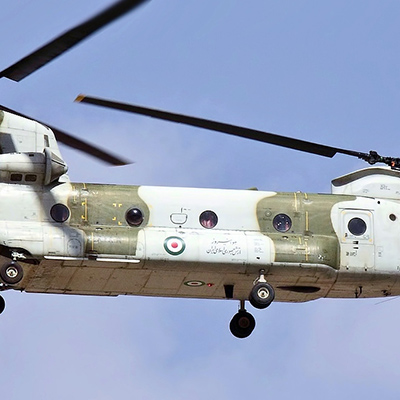Warfare
Chinook
Mohsen Shir-Muhammad
17 Views
The Chinook helicopters, originally developed by Italy, played a crucial role in providing aerial support and transport for Iranian military forces during the Iran–Iraq War. The CH-47 Chinook, manufactured by Italy’s Agusta Bell company (under license from Boeing in the United States), is one of the most powerful helicopters in the world. In addition to its two pilots, the Chinook can carry 44 troops, 24 stretcher patients, or 23450 pounds of cargo,[1] and can reach speeds of up to 288 kilometers per hour. It is also used to transport light and medium artillery, as well as damaged aircraft and helicopters.[2]
Chinook entered service with the Iranian Air Force in 1971.[3] In 1973, the organizational structure of the Iranian Army Aviation (Havanirooz) was approved, based on which Iran decided to purchase heavy-lift Chinook helicopters from the Italian Agusta Bell Company.[4] Stationed at Isfahan General Support Base, two battalions were equipped with Chinook helicopters, each comprising three flight companies.[5] By 1978, Army Aviation had 90 Chinooks,[6] while the Air Force maintained a fleet of 5.[7]
After the victory of the Islamic Revolution and the outbreak of unrest in Kurdistan, Army Aviation helicopters were deployed to support government forces. In March 1979, access to the Kurdistan region by land was effectively impossible, as key roads were under the control of armed separatist groups.[8] For example, Sardasht was besieged by anti-revolutionary elements for two years, from 1978 to 1980, and the supplies for the city’s garrison were delivered by Army Aviation helicopters, including the Chinook.[9] These aerial operations continued until all areas under anti-revolutionary control were liberated. By early 1983, Army Aviation helicopters, including the Bell-214 and Chinook, had logged about 60000 flight hours over 82324 sorties in the region.[10]
When the war began on September 22, 1980, Army Aviation, alongside the Air Force, helped halt the Iraqi advance in Khuzestan and western Iran.[11] As Iraqi forces crossed the Karun River and pushed towards Abadan, they seized control of the roads, cutting off access and movement. The only connection to Abadan Island was via the Bahmanshir River, which was far from Bandar Mahshahr. As a result, helicopters became the most suitable means of moving personnel. Thus, several Army Aviation helicopters, including three Chinooks, were stationed in Bandar Mahshahr, transporting military and volunteer forces with their equipment to Khosroabad Outpost and Choebdeh on Abadan Island, and on the return trip, evacuating war-displaced civilians and the injured back to Mahshahr.[12]
During the series of operations to liberate Khuzestan, Army Aviation operated alongside other units of the Army and the Islamic Revolutionary Guard Corps (IRGC). In Operation Thamen al-Aemmah (as), which broke the siege of Abadan in September 1981, Army Aviation carried out 600 flight hours with 46 helicopters, including 4 Chinooks.[13]
In November 1981, during Operation Tariq al-Quds, 40 Army Aviation helicopters, including 4 Chinooks, flew a total of 4862 hours and transported 4812 Army and IRGC personnel.[14]
In March 1982, during Operation Fath al-Mubin and the liberation of Bostan, 16 Chinooks, together with other Army Aviation helicopters, carried out 3500 sorties, transporting 2840 Iranian troops.[15] During Operation Beit al-Muqaddas in April–May 1982, which led to the liberation of Khorramshahr, Army Aviation deployed 95 helicopters, including 16 Chinooks, and logged approximately 5180 flight hours.[16]
One of the largest Army Aviation deployments in the war took place in Operation Kheibar (the seizure of the Majnoon islands) in February 1984.[17] In this operation, 12 Chinooks were dispatched from Isfahan General Support Base[18] while the Air Force provided 5.[19] A key aspect of the operation was the night-time airlift of troops from Najaf Headquarters (the main assault force) on the first night, carried out by Chinook and Bell-214. For ten nights in Isfahan, Chinook and Bell-214 crews conducted night flight training without night-vision goggles. On the final training flight, the pilots flew the Isfahan–Ahvaz route. Therefore, at 11 PM, they headed south, landing at Ahvaz Airport with lights off, where they remained on standby.[20] Then, on the afternoon of February 22, 1984, they flew from Ahvaz to the designated staging areas, where large numbers of troops were ready to be airlifted to the Majnoon islands. That night, after the command headquarters issued the operation’s code-name, 6 Chinooks—each carrying 60 troops—took off as planned towards the islands, delivering the troops to the target road after a 14-minute flight. Throughout Operation Kheibar, Army Aviation established an aerial transport route between the Jofair area and the Majnoon islands using Chinooks and Bell-214s, flying day and night to transport troops, resupply, and deliver ammunition and equipment at maximum capacity.[21] In total, during Operation Kheibar, 98 helicopters, including 12 Chinooks, logged 1291 flight hours and airlifted 19400 Army and IRGC personnel to the Majnoon islands.[22]
In March 1985, 8 Chinooks were dispatched from Isfahan General Support Base to take part in Operation Badr in the Majnoon islands.[23] One week before the operation began, training exercises were conducted in the Ramhormoz and Ramshir areas. These drills, conducted at different times throughout the day and night, featured Bell-214 and Chinook helicopters practicing airlift operations. The exercises enhanced pilot confidence, increased troop readiness, and shortened the time required for real-world airlifts.[24]
Throughout the six days of Operation Badr, all Bell-214 and Chinook helicopters were engaged in troop airlifts and evacuating the injured from the tactical field hospital on the Majnoon islands to hospitals in Ahvaz and Mahshahr.[25] In total, 49 helicopters, including 8 Chinooks, transported 7165 people, 75 tons of ammunition, and 1659 injured personnel.[26]
On July 21, 1985, an Army Aviation Chinook with three crew members, after taking off from Maragheh in East Azerbaijan Province, was flown via Piranshahr and Haj Omran into Iraq, where its pilots defected.[27]
All Iranian operations were jointly conducted by the Army Ground Forces and the IRGC until 1984, after which the two forces began carrying out operations independently.[28] Nevertheless, in Operation Valfajr 8—an IRGC-led campaign that resulted in the capture of Faw—Army Aviation participated with 80 helicopters, including 10 Chinooks, logging 3938 flight hours.[29]
The Chinook’s final combat role in the Iran–Iraq War was during Operation Mersad (July 1988) when 12 Chinooks dispatched from Isfahan General Support Base, along with other Army Aviation helicopters, flew 425 hours and airlifted 3360 forces into the operational area.[30] In total, Chinook helicopters flew 98000 hours during the war.[31]
After the Iran–Iraq War, Army Aviation helicopters, including the Chinook, took part in relief efforts for those affected by natural disasters. For example, during the 1990 Rudbar earthquake, one Chinook was lost in an accident.[32] Today, Chinooks remain stationed at Army Aviation’s 4th Base in Isfahan[33] where they receive regular maintenance and repairs.[34]
[1] Zeinali, Nasrollah, Amad va Poshtibani Havaie dar Defa Muqaddas (Airborne Logistic Support in the Sacred Defense), Tehran, Markaz-e Entesharat-e Rahbordi-ye NAHAJA, 1394, p. 237.
[2] Ardeshirzadeh, Karim, Hamaaseh-haye Mandegar-e Havanirooz dar Defa Muqaddas (Lasting Epics of Army Aviation in the Sacred Defense), Tehran, Navid Tarahan, 1st ed., 1388, p. 258.
[3] Rahmatinia, Mahdi, Balgardhayee Baraye Rooz-e Mabada (Helicopters for the Day of Need), Mahname-ye Saf, No. 441, Esfand 1396, p. 30.
[4] Maaref-e Jang (War Teachings), Tehran, Entesharat-e Iran Sabz, 1393, p. 256.
[5] Ibid., p. 259.
[6] Darvishi, Farhad, Tajzieh va Tahlil-e Jang-e Iran va Araq, Vol. 1: Risheh-haye Tahajom (Analysis of Iran-Iraq War, Vol. 1: Roots of the Aggression), Tehran, Markaz-e Motaleat va Tahqiqaat-e Jang, 1378, p. 95.
[7] Zeinali, Nasrollah, Ibid., p. 266.
[8] Maaref-e Jang (War Teachings), p. 260.
[9] Ibid., Pp. 262–264.
[10] Quzzat, Rahman, Naqshe Havanirooz dar Daf Ghaele-ye Zed Enqelab az Mantaqe-ye Kordestan (The Role of Army Aviation in Quelling the Anti-Revolutionary Riot in Kurdistan), Mahname-ye Saf, No. 364, Esfand 1389 – Farvardin 1390, p. 79.
[11] Maaref-e Jang (War Teachings), Pp. 262–264.
[12] Ibid., p. 264.
[13] Ardeshirzadeh, Karim, Ibid., p. 54.
[14] Ibid., p. 56.
[15] Ibid., p. 66.
[16] Ibid., Pp. 56, 64, 66, 71.
[17] Shir-Muhammad, Mohsen, Bar Faraz-e Daryaha: Negahi be Tarikh-e Havadarya va Hamaase-ye Eskadran-haye Havanav, Balgard va Balg-e Sabet dar Jang-e Tahmili (Above the Seas: A Look at Naval Aviation and the Epic of Helicopter and Fixed-Wing Squadrons in the Iran-Iraq War), Tehran, Daftar-e Pazhuhesh-haye Nazari va Motaleat-e Rahbordi-ye Niroo-ye Daryayie, 1400, p. 221.
[18] Ardeshirzadeh, Karim, Ibid., p. 96.
[19] Rahmatinia, Mahdi, Ibid., p. 31.
[20] Ardeshirzadeh, Karim, Ibid., p. 98.
[21] Ibid., p. 99.
[22] Ibid., p. 101.
[23] Ibid., p. 103.
[24] Ibid., p. 103.
[25] Ibid., p. 104.
[26] Ibid., p. 107.
[27] Nakhaie, Hadi & Hamid-Reza Mashhadi Farahani, Roozshomar-e Jang-e Iran va Araq, Ketab 37: Toseie Ravabet ba Qodrathaye Asiyayi (Chronology of the Iran-Iraq War, Book 37: Developing Relations with Asian Powers), Tehran, Sepah-e Pasdaran-e Enqelab-e Eslami, Markaz-e Motaleat va Tahqiqaat-e Jang, 1383, Pp. 469–470.
[28] Alaie, Hussain, Ravand-e Jang-e Iran va Araq, Vol. 2 (The Course of the Iran-Iraq War, Vol. 2), Tehran, Nashr-e Marz-o-Boum, 1st ed., 1391, p. 120.
[29] Ardeshirzadeh, Karim, Ibid., p. 115.
[30] Ibid., p. 167.
[31] Maaref-e Jang (War Teachings), p. 277.
[32] Ansari, Muhammad, Man Yek Sarbazam (I am a Soldier), Tehran, Sazman-e Aqidati Siyasi Artesh, 1396, Pp. 161–162.
[33] Havanirooz Nirooi dar Tamam Arseh-ha (Army Aviation: A Force in All Fields), Mahname-ye Saf, No. 455, Tir 1398, p. 25.
[34] Roo-ye Pay-e Khod Istade-im (We Stand on Our Own Feet), Mahname-ye Saf, No. 455, Tir 1398, p. 30.





